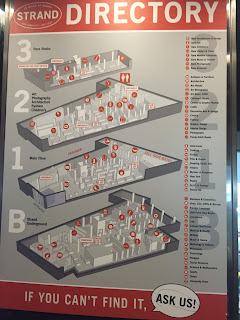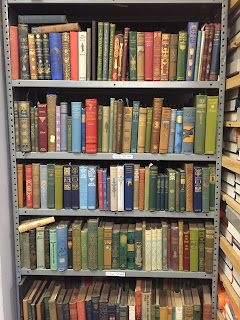Day One
Today started off with me receiving my very own Changing Hands email account!! This account gives me access to the work schedule, employee manual, and various other documents associated with the store. I actually spent a good portion of my first hour reading the employee manual, which was probably the least exciting thing that I got to do today. However, it was interesting to read a little more about Changing Hands' history (and various previous locations) and compare the store as it is now to how it used to be.
Next, I spent a little time learning about how barcodes on books and shelving works. Changing Hands sells both used and new books, so the barcodes are slightly different on each. On new books, the barcode labels are placed on the back of the book (usually where the barcode is printed on the actual book) and are white. However, for used books, the barcode label is put on the front of the book and is white and green and a colored dot sticker is put on the spine. As for shelving, all of the different book genres have a three-letter shorthand (i.e. LIT=Fiction, MYS=Mystery, KTN=Teen/Young Adult Fiction, etc.).
However, I spent the bulk of my time today helping make displays in the Children's section. Some displays are seasonal (like the spring gardening display), others are related to upcoming events (like the Kate DiCamillo and The Cat in the Hat displays), and the rest are just dependent on the types of books and merchandise the store has in stock. Overall, I really enjoyed this part of my day, especially because I got to work with Faith, the woman in charge of the Children's section displays and the storyteller to end all storytellers (Dinotrux and The Princess and the Pony are my new faves).
After grudgingly leaving the Children's section, I got to see how Staff Picks work at the store. Staff Picks are book reviews written by Changing Hands employees that are put on the shelves with the books in order to tell customers a little more about books and why they should consider buying them. Lauren, who is in charge of printing these out (among many other things), explained that the Staff Picks are a way of making the book-buying experience more personal for customers. With the help of these and the knowledgeable employees, customers can receive personalized book recommendations that are simply not possible with the use of algorithms.
Finally, I got to help Joel set up for an event that was to happen later in the night. This was a smaller event of only around 35 people, so the setup was pretty straightforward: some folding chairs facing the front of the room , a chair and whiteboard for the speaker, and a display of the books written by the speaker. The whole setup only took the two of us around 20 minutes and it was a good view into how events are handled at the store.
Day Two
For the majority of today, I was put in charge of culling used books. When Changing Hands takes people's books at the used book counter, it is always taking a gamble. An employee will look at if Changing Hands already carries or carried the book and how well it sold. Sometimes, though used books don't sell like they were expected to ad rather sit on the shelf for more than 9 months. This is when culling come in. The books that haven't sold are taken off of the shelves to be moved to the sale section and, if they still don't sell, to be donated. I culled books from the science fiction, science, and children's sections.
I also got to take a break from culling and work with Brandi, who is the children's book buyer. It was really interesting to see how she chose how many of which books to buy. A lot of times, she would only purchase a handful of copies, maybe only one.It all depends on past sales history and what customers have been asking for.
Day Three
Today I spent the majority of my day with Jazmin, the Assistant Gift Buyer. She showed me all of the different gift displays around the store, explaining how the gifts had to cater to Changing Hands' diverse customer base. Next, we changed over some of the displays in the children's section (even one of the displays I had worked on just two days ago). She explained that the displays are constantly being altered to try to highlight different products. The displays we worked on involved a new shipment of rabbit stuffed animals and were spring-themed.
After we finished the displays, Jazmin showed me how she does gift buying. Most of it has to do a lot with experience, knowledge of the products, and knowledge of what customers have been asking for. She tries to make sure that there are constantly unique products in stock that set Changing Hands apart from its competition.
Jazmin is also one of the six girls in charge of the Changing Hands Instagram account. She showed me the schedule that they use to coordinate posts (the account is for both stores) and I even got to help her make a post.
Unfortunately, my time with Jazmin eventually came to an end, but I'm positive I will be working with her again sometime in the future. However, I did get to help out behind the used book counter with Robert. There were a few people who came in to trade their books, so I got to see how the selection process works. I mentioned this a little bit when I was talking about culling, but Robert mainly used sales history to determine if he should take a book to be sold. Again, a lot of the decisions relied on his experience as well as his personal knowledge of books. After deciding which books he'll take from a trade, he'll mark them with prices and tally all of the prices up, giving the customer 50% of what he will sell them for in the form of store credit.
~~~~~~~~~~~~~~~~~~~~~~~~~~~~~~~~~~~~~~~~~~~~~~~~~~~~~~~~~
In my first week at Changing Hands, I already got to learn so much about the store and how it works. Everyone has been very inviting and patient as I learn the ropes. I can't wait to see what next week holds, but until then, happy reading!















































